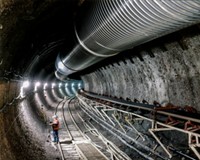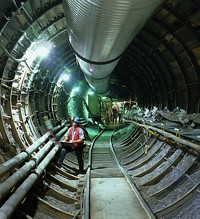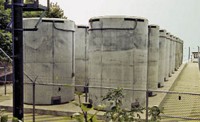Advertisement
Grab your lab coat. Let's get started
Welcome!
Welcome!
Create an account below to get 6 C&EN articles per month, receive newsletters and more - all free.
It seems this is your first time logging in online. Please enter the following information to continue.
As an ACS member you automatically get access to this site. All we need is few more details to create your reading experience.
Not you? Sign in with a different account.
Not you? Sign in with a different account.
ERROR 1
ERROR 1
ERROR 2
ERROR 2
ERROR 2
ERROR 2
ERROR 2
Password and Confirm password must match.
If you have an ACS member number, please enter it here so we can link this account to your membership. (optional)
ERROR 2
ACS values your privacy. By submitting your information, you are gaining access to C&EN and subscribing to our weekly newsletter. We use the information you provide to make your reading experience better, and we will never sell your data to third party members.
Energy
Bush Presses For Nuclear Recycling
Reprocessing spent fuel would increase risk of nuclear weapons proliferation, critics charge
by Glenn Hess
March 27, 2006
| A version of this story appeared in
Volume 84, Issue 13

In a break with decades of U.S. policy, the Bush Administration is asking Congress to provide start-up funding for an ambitious policy initiative that is designed to expand nuclear power generation worldwide while keeping atomic technologies and materials out of the hands of terrorists.
The program, called the Global Nuclear Energy Partnership (GNEP), "has the potential to change the world," Department of Energy Secretary Samuel W. Bodman declared last month at the venture's unveiling. "GNEP brings the promise of virtually limitless energy to emerging economies around the globe in an environmentally friendly manner while reducing the threat of nuclear proliferation."
Bodman noted that the Energy Information Administration recently estimated that global demand for energy may increase by as much as 50% by 2025, with more than half of that growth coming from the world's developing economies. Nuclear power, he said, is an "abundant, safe, reliable, and emissions-free way to help meet this growing demand for energy throughout the world." As part of the GNEP strategy, Bodman said, the U.S. would work with key international partners to develop and demonstrate "new proliferation-resistant technologies" to recycle used or "spent" nuclear fuel to reduce waste.
The program is going to take time and will be expensive. Testifying before the House Science Committee on Feb. 15, Bodman said the Administration's request of $250 million for GNEP in fiscal 2007 will be followed by a $700 million request in fiscal 2008 and an $800 million to $900 million request in fiscal 2009. He said this preliminary effort should allow the U.S. to decide by 2008 whether to proceed with large-scale testing of the technologies. Bodman said the project could cost the U.S. as much as $40 billion over its first 10 years but that contributions from other countries "could substantially reduce that cost."
The energy secretary emphasized to the science panel that the Administration would continue to pursue development of the permanent underground disposal site for nuclear waste at Yucca Mountain in Nevada. But based on technological advancements in fuel reprocessing that would be made through GNEP, Bodman said, the volume and radiotoxicity of waste requiring permanent disposal could be greatly reduced, thereby delaying the need for an additional repository indefinitely.
"Even with the successful development of a recycling program, there will remain a significant amount of 'once-through' spent nuclear fuel that will require final disposal in a repository," he said. Located 100 miles northwest of Las Vegas, the Yucca Mountain repository is intended to store up to 77,000 tons of high-level radioactive waste. Spent fuel from commercial nuclear power plants is now stored aboveground at more than 70 locations at reactors in 35 states. The Yucca Mountain project has encountered numerous delays and is expected to open no earlier than 2012. The Administration's fiscal 2007 budget proposal includes $545 million for the Nevada storage facility.
Conventional nuclear fuel reprocessing requires the separation of pure plutonium from the other elements in the spent nuclear fuel. A major concern has been that the refined plutonium might be obtained by terrorists and used to make nuclear weapons. Under the proposed GNEP plan, the U.S. and other countries with advanced nuclear technologies, such as the U.K., France, and Russia, would develop a new reprocessing technology in which plutonium would remain bound with other highly radioactive materials.

If the project were successful, the U.S. and its partners would provide fresh nuclear fuel and small nuclear reactors to electricity-hungry developing nations. In return, these user nations would agree not to build uranium enrichment and recycling facilities of their own, and spent fuel would be returned to the original supplier for reprocessing. The recycled fuel would then be used in a new type of reactor in fuel-supplier nations.
Twelve of the 33 nations that generate electricity from nuclear power plants already practice spent-fuel reprocessing, but it has not been done in the U.S. for nearly three decades, according to the Nuclear Energy Institute, an industry trade group. The U.S. developed technology to reprocess spent nuclear fuel in the 1950s as a way to obtain plutonium for atomic weapons, but then-president Jimmy Carter banned the practice in 1977 because of proliferation concerns. One result of that policy has been the piling up of high-level radioactive waste at commercial nuclear power-plant sites.
"In the 1970s, the U.S. decided to abandon its leadership on nuclear recycling and let the rest of the world pass us by," Senate Appropriations Energy & Water Subcommittee Chairman Pete V. Domenici (R-N.M.) remarked at a March 2 hearing. "With the creation of GNEP, we're getting back in the game. This program is the next step in the global nuclear renaissance." Domenici said he would support the Administration's initial funding request. "I don't know the final price. But I think we ought to proceed step-by-step," he said.
Deputy Secretary of Energy Clay Sell told the Senate appropriations panel that the $250 million would be used to demonstrate, on an engineering scale, a new reprocessing technology called Uranium Extraction Plus (UREX+), which he described as a "multistep process that would separate the usable components in spent nuclear fuel from its waste components without separating pure plutonium." Unlike the existing reprocessing technology (Plutonium-Uranium Extraction, or PUREX) used in Europe and Asia, Sell said, UREX+ leaves plutonium and other long-lived transuranic elements mixed together, thereby making the end product unsuitable for weapons. "The rest of the world has deployed PUREX on a commercial scale, resulting in 250 tons of plutonium that is now in commerce around the world today," Sell testified. "That presents a significant, generational proliferation concern."
He said DOE's Argonne National Laboratory has successfully demonstrated the entire UREX+ process in hot cells and gloveboxes and is preparing for scale-up. A demonstration plant would cost between $700 million and $1.5 billion. "We would hope to begin construction in 2008 and complete construction in three to four years to begin operations," Sell told lawmakers.
The recycled fuel would be used in new advanced burner reactors (ABR), which would break down the radioactive metals into lighter fission products while extracting their energy. "The ABR would destroy transuranics in used fuel from nuclear power plants, avoiding the need to accommodate this radioactive, radiotoxic, and heat-producing material in a geological repository for hundreds of thousands of years while it decays," Sell said. He indicated that the Administration plans to spend $2 billion to build a test reactor that could burn fuel produced by the UREX+ process. The unit would be about one-tenth the size of a current nuclear power plant; the goal is to be operational around 2014. The next phase of the plan, Sell said, would demonstrate a commercial-scale ABR that would have approximately the same capacity as current nuclear power plants. If all goes well, the Administration believes, the international atomic network could be up and running by 2025.
The idea of a major program to reprocess and utilize nuclear fuel has not been met with universal approval. The initiative has been sharply criticized by several lawmakers who charge that GNEP is far too costly and would not address the country's current energy problems.
"From what I can tell, this new proposal has not gone through the necessary peer review, it is without strong economic cost analysis, and it does nothing to address our energy needs in the near or midterm," Sen. Patty Murray (D-Wash.) remarked at the March 2 hearing. The notion of accepting other countries' spent fuel at a time when the U.S. has had trouble disposing of its own nuclear waste could also prove highly controversial. "Before we go any further, I have to point out that this proposal seems to gloss over the difficulty this country has in managing nuclear waste," Murray said.
Sell said GNEP would save the U.S. money in the long run because reprocessing spent fuel would dramatically reduce the toxicity and overall amount of nuclear waste that would require permanent storage and thus eliminate the need for additional repositories through the end of the century. Approximately 90% of the waste from commercial nuclear reactors destined for ultimate disposal at Yucca Mountain could be reprocessed for additional use, he told the panel.
The waste-reprocessing plan has also raised concerns among pronuclear members of Congress who say they are more interested in seeing the Yucca Mountain repository built. "I am concerned that this sprawling new venture may divert DOE's attention from other immediate concerns such as fulfilling its current responsibility with respect to Yucca Mountain," Rep. John D. Dingell of Michigan, ranking Democrat on the House Energy & Commerce Committee, stated at a March 9 hearing on DOE's fiscal 2007 budget request. Dingell added that the potential cost of the program is "staggering" and DOE's track record for developing such large-scale projects is "less than reassuring."
Rep. Joe L. Barton (R-Texas), committee chairman, said he believes that the reprocessing plan "may be overly broad, and it may be premature." Barton said he agrees with the goal of expanding the use of nuclear power and is "not opposed" to reprocessing spent fuel. But he expressed frustration that the Administration wants to cut funding for clean coal plants, deepwater drilling, and other programs authorized by the Energy Policy Act of 2005 while proposing costly new initiatives like GNEP.
"Put me down as publicly respectful, but I am not a supporter," Barton remarked. "I'm not going to start down that trail until we finish other trails we started." The Texas Republican said DOE should focus on completing the Yucca Mountain project. "Personally, I'm willing to tolerate this pursuit of the GNEP dream, but not at the expense of a nuclear waste repository."
The Administration's reprocessing initiative also is strongly opposed by nuclear nonproliferation advocacy groups that fear the new technologies would increase the risk of nuclear terrorism. "DOE's new reprocessing technology has never been demonstrated even at a pilot-plant scale," says Ivan Oelrich, vice president of strategic security at the Federation of American Scientists. "The reprocessing technology can be more or less proliferation-resistant but never made proliferation-proof. And the fuel produced by this hypothetical process could only be burned in new fast neutron reactors that have never been commercially successful and never produced in great number."
Edwin Lyman, senior scientist at the Union of Concerned Scientists, maintains that the reprocessing program would pose a serious risk that terrorists could acquire the material needed to make a nuclear weapon from a U.S. facility. He says less than 20 lb of plutonium is needed to make a nuclear bomb. "If the plutonium remains bound in large, heavy, and highly radioactive spent-fuel assemblies, it is nearly impossible to steal," Lyman says. "In contrast, separated plutonium is not highly radioactive and is stored in a concentrated powder form."
Despite Administration arguments that the new reprocessing technologies would leave the plutonium blended with other elements, such as neptunium, resulting in a mixture too radioactive to steal, Lyman maintains that this notion is incorrect. "Neither neptunium nor the other elements under consideration are radioactive enough to deter or preclude theft," he says. Lyman also asserts that a U.S. reprocessing program would add to the worldwide stockpile of roughly 240 metric tons of separated plutonium that sits in storage today, enough for some 40,000 nuclear weapons. Reprocessing the U.S. spent fuel generated to date, he says, would increase this stockpile by more than 500 metric tons. "The safest thing to do with plutonium is to leave it in spent fuel," says Lyman. "Experts agree that no reprocessing technology developed or proposed to date is proliferation-proof."
Opponents also worry that reprocessing makes it easier for nations to develop nuclear weapons. For example, Arjun Makhijani, president of the Institute for Energy & Environmental Research (IEER) in Takoma Park, Md., says Japan has a large stock of separated plutonium but has not yet used any as fuel for a commercial power reactor. He points out that Japanese politicians have spoken in recent years about making nuclear weapons. "Japan's Labor Party chief, Ichiro Ozawa, suggested in 2002 that Japan could use its commercial plutonium to make thousands of nuclear weapons if China got too uppity," Makhijani notes. Japan could become a full-fledged nuclear weapons state in approximately six months, according to IEER calculations.
Advertisement
Sell acknowledged these concerns in his testimony before the Senate appropriations subcommittee, but he stressed that the U.S.'s refusal to reprocess spent fuel has been a stance "that virtually no one else followed." The U.S., he said, can either continue down the same path it has been on for the past 30 years or "lead a transformation to a new, safer, and more secure approach to nuclear energy, an approach that brings the benefits of nuclear energy to the world while reducing vulnerabilities from proliferation and nuclear waste." He concluded by asserting that the development of new technologies that make it more difficult to obtain plutonium "will make the U.S. a leader rather than a spectator."





Join the conversation
Contact the reporter
Submit a Letter to the Editor for publication
Engage with us on Twitter